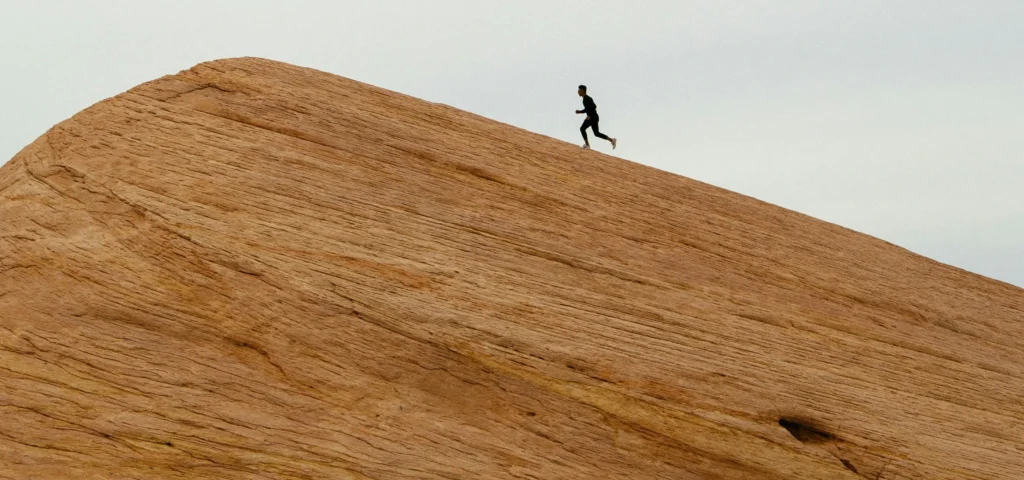When we think about running today, we often relate it with health, competition, or even as a stress reliever. But if we take a trip back in time, we’ll find that the origin of running was essential for the survival of early humans. Running allowed our ancestors to hunt animals, travel long distances, and flee from danger. The running helped shape human evolution, giving us an edge in the wild.
Our early ancestors began walking upright about 6 million years ago, marking the beginning of bipedalism, which would eventually evolve into more specialized running behaviors.
Why Did Early Humans Run?
Running wasn’t always a choice; it was a necessity. Early humans, living in harsh environments with constant threats, had to rely on physical endurance and speed to survive. Food was scarce, and predators roamed the land. The ability to run swiftly meant the difference between life and death.
Australopithecus, a genus that emerged around 4 million years ago, showed significant shifts towards ground-dwelling and bipedal locomotion. These early forms of walking and running became key to their survival as they spent more time on the ground than in trees.
Running for Hunting:
One of the most significant reasons early humans ran was for hunting. Unlike modern humans, our ancestors didn’t have sophisticated weapons. Instead, they relied on a technique called “persistence hunting,” which involved chasing animals until they became too exhausted to continue.
This endurance-based hunting method is supported by accounts of persistence hunting, where historical descriptions from 1527 to the early 20th century documented such practices across various cultures. A study even identified 391 historical descriptions of endurance hunting, showing how widespread and essential running was for survival.
Escaping Predators:
As much as early humans used running to hunt, they also had to run to escape predators. Whether it was a pack of wolves or a lurking saber-toothed tiger, the ability to outrun danger was critical. Early humans were not the top predators; they were often the prey.
By running, they could navigate through forests, open plains, or rocky terrains to reach safety. Running, in this context, wasn’t just about speed but also endurance and agility.
The Birth of Endurance Running:
Humans may not be the fastest creatures, but they are among the best at endurance running. Our ability to sweat and cool down our bodies while running long distances gave early humans an edge over animals that could sprint but not maintain the pace. In fact, this skill played a key role when running was invented as a hunting strategy, allowing humans to exhaust prey over long distances.
Homo erectus, which appeared around 1.9 million years ago, was one of the first species to show adaptations for long-distance running. This species had physical features like longer legs and a more developed sweat system, allowing them to run for extended periods without overheating. These adaptations, which likely began evolving nearly 2 million years ago, became key to survival in the hot African savannas.
Evolutionary Advantages:

Running provided early humans with important evolutionary benefits, helping them survive and thrive in harsh environments. Those who could run efficiently were better equipped to hunt, escape danger, and endure long distances. Over millions of years, the human body adapted to make running more effective. Here are some key evolutionary changes:
- Running helped improve cardiovascular health and stamina.
- The body became more energy-efficient through running.
- Fossil evidence shows efficient running has been present for at least 4.5 million years.
- Humans developed longer legs and strong foot arches for better running ability.
- A larger gluteus maximus (buttocks) helped stabilize the body during running.
- These adaptations allowed humans to run long distances and handle environmental challenges.
The Role of Running in Social Bonds:
Running didn’t just have physical benefits; it also played a role in strengthening social bonds. Imagine an early hunting group working together to chase down prey. Running side by side, they would have to communicate, plan, and support each other.
Running as a collective effort was not only about survival but also about community-building. This teamwork helped form early human social structures, which eventually led to more complex societies.
Running in Ancient Cultures:
As humans began to develop societies and cultures, running transitioned from a survival tool to something more symbolic. Ancient cultures like the Greeks saw running as a way to honor the gods, test physical limits, and compete against one another.
The ancient Olympic Games, for example, featured running races that were as much about glory as they were about strength and speed. The Greeks believed that a strong, fast body was a reflection of a person’s inner strength and character.
Transition of Running from Survival to Sport:

Over time, running evolved from a survival mechanism to a form of sport. In ancient civilizations, races were held as a means of training for battle, proving one’s physical prowess, or even offering entertainment. The shift from running for survival to running for sport marked a significant change in human behavior.
As civilizations grew and technology advanced, humans no longer needed to run for food or to escape predators. Instead, running became a symbol of human endurance, competitiveness, and strength.
Running in the Modern Era:
Today, running is a global phenomenon, enjoyed by millions of people worldwide. From marathons to recreational jogs in the park, the reasons people run have drastically changed. No longer tied to survival, running is now seen as a way to maintain health, relieve stress, and compete in races.
However, the origins of running remain a fascinating reminder of our species’ history. Every time you lace up your running shoes, you’re participating in an ancient tradition that dates back to early humans chasing prey and escaping predators.
Conclusion
The story of running is deeply intertwined with human survival and evolution. From persistent hunting to escaping predators, running allowed our ancestors to survive in a dangerous world. With its roots tracing back over 6 million years, the evolution of running highlights the endurance and adaptability of the human species. Whether for sport or health, running continues to be a testament to our remarkable ability to evolve and overcome.
FAQs
1. When Did Humans Start Running?
Early ancestors of modern humans began walking upright around 6 million years ago, which eventually led to the development of running for survival.
2. What is Persistence Hunting?
Persistence hunting is a method where early humans would chase prey over long distances until the animal became too exhausted to escape.
3. How Did Running Help Early Humans Survive?
Running allowed early humans to hunt efficiently, escape predators, and travel long distances, all of which were crucial for survival.
4. How Did Endurance Running Evolve?
Homo erectus, which appeared about 1.9 million years ago, showed adaptations for long-distance running, such as longer legs and a better cooling system through sweating.
5. What Physical Adaptations Made Early Humans Good Runners?
Humans evolved with features like longer legs, efficient foot arches, and the ability to sweat, which helped in maintaining endurance during long-distance running.












